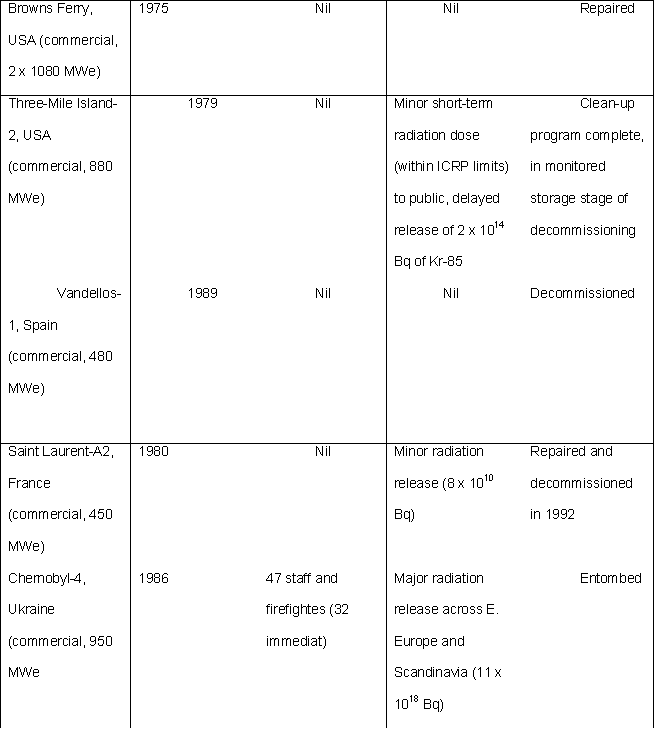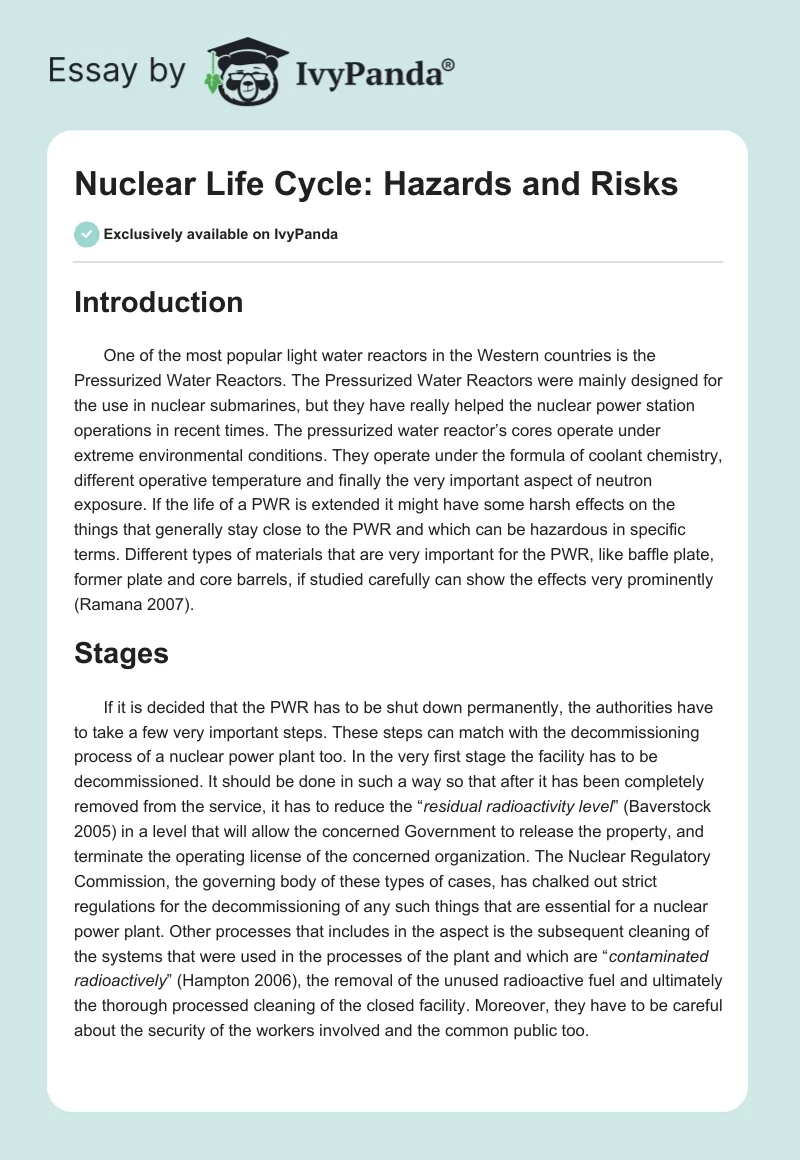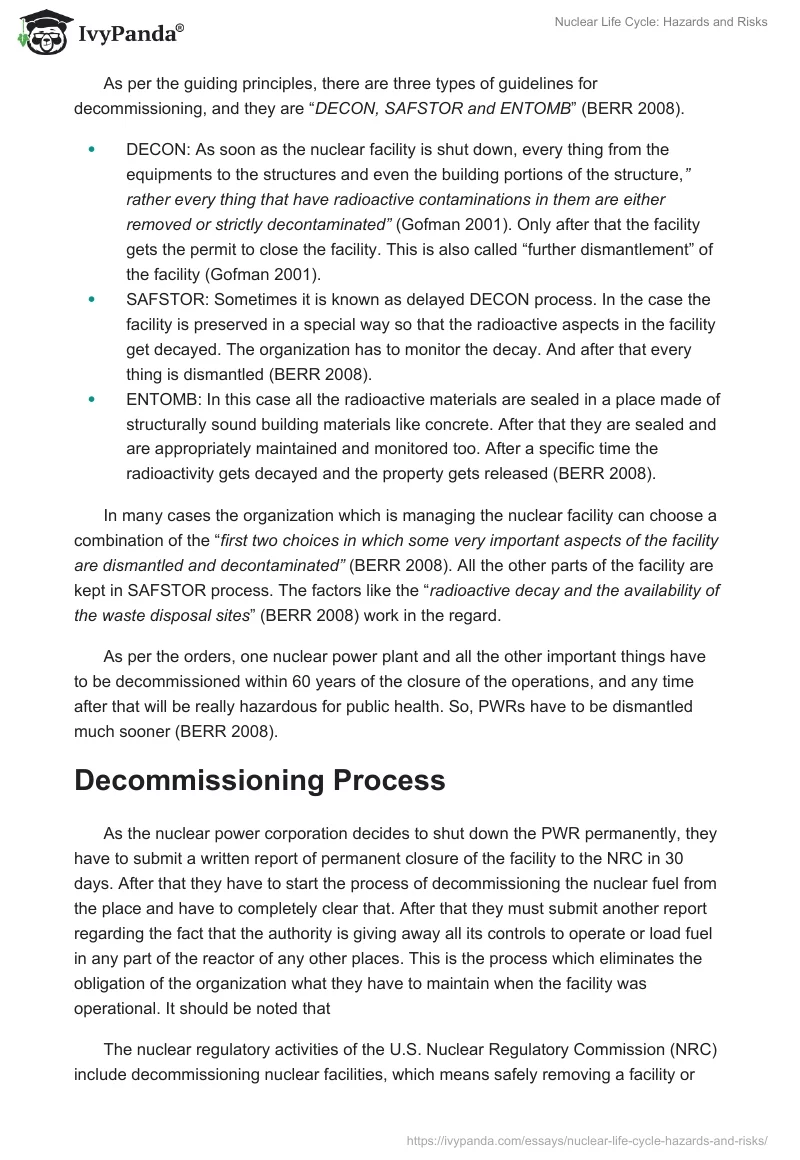Introduction
One of the most popular light water reactors in the Western countries is the Pressurized Water Reactors. The Pressurized Water Reactors were mainly designed for the use in nuclear submarines, but they have really helped the nuclear power station operations in recent times. The pressurized water reactor’s cores operate under extreme environmental conditions. They operate under the formula of coolant chemistry, different operative temperature and finally the very important aspect of neutron exposure. If the life of a PWR is extended it might have some harsh effects on the things that generally stay close to the PWR and which can be hazardous in specific terms. Different types of materials that are very important for the PWR, like baffle plate, former plate and core barrels, if studied carefully can show the effects very prominently (Ramana 2007).
Stages
If it is decided that the PWR has to be shut down permanently, the authorities have to take a few very important steps. These steps can match with the decommissioning process of a nuclear power plant too. In the very first stage the facility has to be decommissioned. It should be done in such a way so that after it has been completely removed from the service, it has to reduce the “residual radioactivity level” (Baverstock 2005) in a level that will allow the concerned Government to release the property, and terminate the operating license of the concerned organization. The Nuclear Regulatory Commission, the governing body of these types of cases, has chalked out strict regulations for the decommissioning of any such things that are essential for a nuclear power plant. Other processes that includes in the aspect is the subsequent cleaning of the systems that were used in the processes of the plant and which are “contaminated radioactively” (Hampton 2006), the removal of the unused radioactive fuel and ultimately the thorough processed cleaning of the closed facility. Moreover, they have to be careful about the security of the workers involved and the common public too.
As per the guiding principles, there are three types of guidelines for decommissioning, and they are “DECON, SAFSTOR and ENTOMB” (BERR 2008).
- DECON: As soon as the nuclear facility is shut down, every thing from the equipments to the structures and even the building portions of the structure,” rather every thing that have radioactive contaminations in them are either removed or strictly decontaminated” (Gofman 2001). Only after that the facility gets the permit to close the facility. This is also called “further dismantlement” of the facility (Gofman 2001).
- SAFSTOR: Sometimes it is known as delayed DECON process. In the case the facility is preserved in a special way so that the radioactive aspects in the facility get decayed. The organization has to monitor the decay. And after that every thing is dismantled (BERR 2008).
- ENTOMB: In this case all the radioactive materials are sealed in a place made of structurally sound building materials like concrete. After that they are sealed and are appropriately maintained and monitored too. After a specific time the radioactivity gets decayed and the property gets released (BERR 2008).
In many cases the organization which is managing the nuclear facility can choose a combination of the “first two choices in which some very important aspects of the facility are dismantled and decontaminated” (BERR 2008). All the other parts of the facility are kept in SAFSTOR process. The factors like the “radioactive decay and the availability of the waste disposal sites” (BERR 2008) work in the regard.
As per the orders, one nuclear power plant and all the other important things have to be decommissioned within 60 years of the closure of the operations, and any time after that will be really hazardous for public health. So, PWRs have to be dismantled much sooner (BERR 2008).
Decommissioning Process
As the nuclear power corporation decides to shut down the PWR permanently, they have to submit a written report of permanent closure of the facility to the NRC in 30 days. After that they have to start the process of decommissioning the nuclear fuel from the place and have to completely clear that. After that they must submit another report regarding the fact that the authority is giving away all its controls to operate or load fuel in any part of the reactor of any other places. This is the process which eliminates the obligation of the organization what they have to maintain when the facility was operational. It should be noted that
The nuclear regulatory activities of the U.S. Nuclear Regulatory Commission (NRC) include decommissioning nuclear facilities, which means safely removing a facility or site from service and reducing residual radioactivity to a level that permits (Nuclear Regulatory Commission 2010).
After two years of the organization’s submission of the certificate showing the cause of permanent closure, they have to again submit a report which is formally known as the Post Shutdown Decommissioning Activities Report or popularly known as PSDAR to the NRC committee. In the report they have to clearly mention their plans of how they will decommission all the products that were operational, and a schedule that will show what will be the procedures that will accompany the closing. They will also have to submit an estimated cost for the removal process (Burgman 2005).
Another most important factor is that the PSDAR must clearly discuss all the environmental activities they will undertake along with the decommissioning process and what will be their substitute steps if one step fails. They will have to clearly keep in mind what are the different environmental analysis that happened during the earlier cases of decommission. Sometimes they have to wait for the NRC to approve their processes and all the other additional impacts they believe that can happen while they try to decommission their products (DTI 2003).
Next, NRC publishes a notice which says that they have allowed the closure of the facility. Public reviews are sought on the matter and also the NRC on their part holds a general public meeting which generally comprises of the residents who live near the plant to discuss about the possible processes that the organization will take for the decommissioning.
After all the licenses and reports the major work begins, and this is the physical process of decommissioning. These activities can be of different types, from permanent removal of the reactor vessel, to other different things like the generators, pipe systems and all the co-related things.
However, both the NRC authorities and the organization who were heading the plant must look into several factors. The site must not be released immediately for general use. Along with being careful about the environmental aspects of the decommissioning process they have to be very careful about any adverse effect that can be faced by them in the process (Goodin 2003).
However, in recent times it is seen that most of the risks that happened in many cases are no more to be seen in recent times. Due to the meticulous planning of the decommissioning processes, the use of skilled labors and machines and along with other aspects, the risks are getting lesser day by day. Health and Safety Executive is instrumental in this context. Health and Safety Executive (2010) reports, “To ensure that adequate and balanced programmes of nuclear safety research continue to be carried out, based on a view of the issues likely to emerge both in the short and long term” (Health and Safety Executive 2010).
Protective Measures
There has to be a huge amount of physical protection for the displacement of the materials. As these materials are extremely hazardous so the organization has to be extremely careful while transporting them. They have to use physical protection from all the necessary security forces. And more over, all the employees working on the project must have to be dressed in radioactive suits in case for any accident like sudden burst of radioactivity (Taylor 2007).
In doing the processes the organization has to prepare for every possible measure that can be applied in the case. They have to be extra careful on the event like nuclear accidents. Below there is a list of accidents in the nuclear power sites.


All the major accidents have happened in facilities that were active and in the process of production. But still it does not give any assurance that the decommissioned facilities cannot do any harm. We can check some protective measures for the PWR. As per Petrangeli (2006), the protective measures should include “monitoring of the principal characteristics of the plant state; controlling the core sub-criticality; restoring the core cooling and preserving the longtime cooling” (Petrangeli 2006). However, there are other measures too.
- Recruitment of skilled staffs: In any aspect that deals directly with such serious issues like nuclear power plants, the organization which is overseeing the decommissioning processes must recruit qualified staffs. The materials that are being moved or in many cases entombed are extremely hazardous for the environment. They must take on every safety measures in all the aspects that can rise (Neal 2006).
- The involvement of Local Security Authorities: The organization must involve all the local securities like the police, military and private security forces for any emergency situation that may arise in the case. This also will help the smooth transportation or other types of regular needs that will arise in the case.
- Extensive promotional Campaign regarding the Disposal: The local people must be aware of the ongoing process of decommissioning of the radioactive materials (UK CEED 2002).
Apart from these it is important for governments to take the matter very seriously. Fortunately, International Atomic Energy Agency (2007) indicates that.
There is increasing awareness among governments and interested parties regarding the need for early planning, adequate funding and long term strategies for decommissioning, waste and spent fuel management (International Atomic Energy Agency 2007).
However, the aspects of Worker risks in the decommissioning stage and protective measure for these risks can be enumerated as a tabular format.
International Standards
The decommissioning of radioactive materials is generally called “Radioactive Waste Management” (Ramana 2007). The organization has to take the full responsibility for all the wastes and residues, so that it might not cause any harm. There are different safe methods for the final disposal of all the high level radioactive wastes.
In the power producing process, all the nuclear fuel cycle, every step produces radio active wastes. The proven technologies for the waste disposal are implemented in all the cases. In the cases, 99% of the radioactivity is associated with the fuel. Apart from “the surface contamination of the plant, the radioactivity mainly occurs from activation products like steel components” (Ramana 2007) which are generally kept in radiation exposed for a very long time. Sometimes due to extensive exposure to the radioactivity, the atoms change into different isotopes, and if they change into isotopes like “iron-55 and cobalt-6o”, (Ramana 2007) the authority has to be careful as they are highly radioactive and some times emit gamma rays, and they must be identified and embedded for more than 50 years, so their radioactive property must die out.
“Some other scrap materials in the process have to be recycled” (Ramana 2007). But most of the materials must be buried in the earth as they generally have low clearance levels. There is a difference in short lived wastes and long lived wastes. The short lived are given a shallow burial while the long lived wastes are disposed in deep underground chambers.
After that the very low level liquid wastes, as per international standards are disposed into the sea. They can emit small amounts of radioactive gases like “krypton-85, xenon-133” (Baverstock 2005) into the atmosphere as they are chemically inert.
Conclusion
Still in the final analysis we have to look at the different risks that can be associated with the disposal of the PWR. In many cases the researchers say that in the process in every 10000 people 1 can die, while dealing with these processes. It is really an over statement, but there are plans for decommissioning in the space. There are experiments going on this aspect (Hampton 2006).
But in this aspect we have to look about the feature that what is the financial condition of the firm that is overseeing the decommissioning process. The parent company must provide enough money for the successful decommissioning of the waste. The public involvement is also matters, so that there are no unnecessary panics from the end of the public. There was a very difficult issue that arose in the 1990s. At that time several nuclear plants ceased their operations and subsequently began the decommissioning process, but the governments could not provide suitable disposal places for the plants. The events of Chernobyl were still fresh in the mind of the people and in every case the people became panicked (Neal 2006).
The events prompted different Governments along with NRC to determine some emergency steps so that the decommissioning process can be safe and it does not give any types of insecurity to the common people. In recent times, with the subsequent development of technology and different processes, the decommissioning has become a lot safer and the risks are decreased in a visible way. Still accidents happen during the processes and the governing bodies along with the parent companies must come up with more and more effective strategies so that it becomes safer and less perilous (Gofman 2001).
Reference list
Baverstock, K., 2005. The UK Committee on Radioactive Waste Management. Journal of Radiological Protection, 25 (2005), pp. 313-320.
BERR., 2008. The Future of Nuclear Power: Analysis of Consultation Responses. London: Department for Business, Enterprise and Regulatory Reform.
Burgman, M., 2005. Risks and Decisions for Conservation and Environmental Management. Cambridge: Cambridge University Press.
DTI., 2003. Our Energy Future – Creating a Low Carbon Economy. London: Department of Trade and Industry.
Gofman, J., 2001. Poisoned power: The case against nuclear power plants. Emmaus: Rodale Press Inc.
Goodin, R., 2003. Reflexive Democracy. Oxford: Oxford University Press.
Hampton, W., 2006. Meltdown: A race against nuclear disaster at Three Mile Island. Cambridge: Candlewick Press.
Health and Safety Executive., 2010. Nuclear Safety Advisory Committee Sub-Committee on Research. Hse. Web.
International Atomic Energy Agency., 2007. Nuclear Safety Review for the Year 2007. IAEA. Web.
Neal, M., 2006. Risk assessment & management: A definitive method for proactive risk manipulation. United States of America: Targeted Security Consultants Ltd.
Nuclear Regulatory Commission., 2010. Decommissioning of Nuclear Facilities. NRC .
Petrangeli, G., 2006. Nuclear Safety. Burlington: Elsevier Butterworth-Heinemann.
Ramana, M., 2007. Nuclear Power: Economic, Safety, Health, and Environmental Issues of Near-Term Technologies. Annual Review of Environment and Resources, 15, (34), pp. 136-142.
Taylor, S., 2007. Privatisation and Financial Collapse in the Nuclear Industry: The Origins and Causes of the British Energy Crisis of 2002. London: Routledge.
UK CEED., 2002. Reconvening of Consensus Conference to Consider DEFRA’s Consultaton Paper: Managing Radioactive Waste Safely. Peterborough: UK Centre for Economic and Environmental Development.


